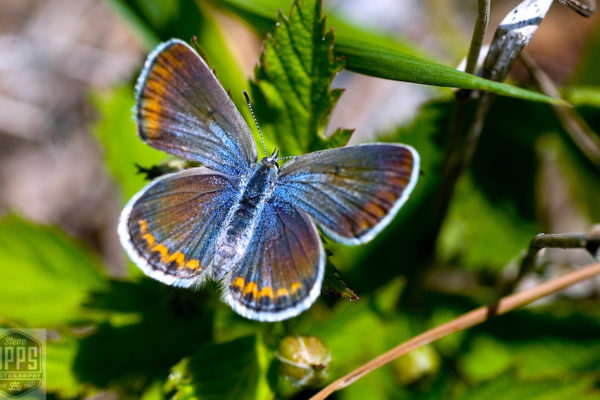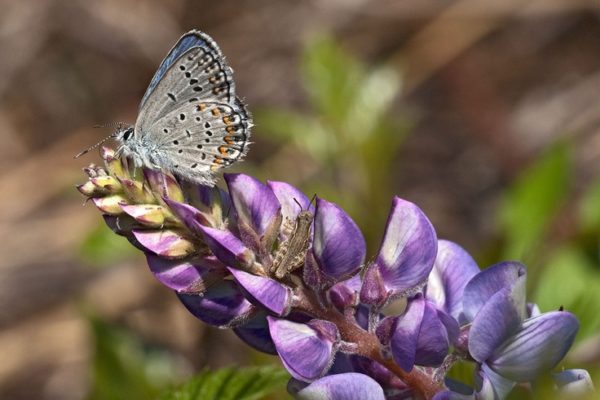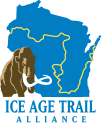By Kevin Thusius, Director of Land Conservation

One-inch wing-span. Brilliant blue on top. Orange dots under wings. Size of a nickel.
This description is of a rather rare insect that resides in central Wisconsin – the Karner blue butterfly (Lycaeides melissa samuelis). Its existence is so threatened it was placed on the federal endangered species list in 1992.
Its tiny size makes it easy to miss as it flits between grasses and wildflowers, and because it doesn’t attract a lot of attention, it’s disappearance from our Midwest landscape might not seem like such a big deal. Yet, each and every species, like the Karner blue butterfly, plays a valuable ecological role in nature. Each loss destabilizes this fragile balance. As the folks at the U.S. Fish and Wildlife Service point out, “experience has proven that many plants and animals have properties which will prove beneficial to humans as sources of food and medicine. With the loss of each species, we lose a potential resource for improving the quality of life for all humanity.”
Why is it so rare?
Karner blue butterflies are endangered primarily because the prairie and savanna habitats they depend on for survival have diminished as land has been cleared for farming and for residential and commercial purposes. The habitat they require is very specific and includes significant patches of wild lupine (Lupinis perennis) – it is the only host plant for their larvae.
As a result of this habitat loss, the Karner blue vanished in five of the twelve states in which it used to exist. Fortunately, the glacial sands deposited during the last Ice Age in central Wisconsin have provided just the right conditions to retain small populations of these butterflies.

What does this little blue butterfly have to do with the Ice Age Trail?
Since efforts began to revive the Karner blue, it has shown some improvement in its abundance due to programs dedicated to protecting and improving critical habitats such as prairie, savanna, and oak barrens. However, recovery has been slow. Diminished habitat makes it difficult for the various butterfly populations to intermix and disperse. The linear green space of the Ice Age Trail across private and public lands naturally creates important dispersal corridors which enable isolated Karner blue populations to connect and expand their range.
The Ice Age Trail Alliance is eagerly partnering with the U.S. Fish and Wildlife Service because the Alliance is uniquely suited to assist with this project. Our years of corridor planning for future trail has brought us in contact with many supportive landowners in Portage, Waupaca, Waushara and Marquette counties which are within what is known as the Morainal Sands Recovery Unit, a region which is home to this tiny, delicate butterfly.
“With 82% of Wisconsin’s land in private ownership, it is important to work with private landowners through cooperative conservation programs.”
Kurt Waterstradt, Wisconsin Private Lands Coordinator for the U.S. Fish and Wildlife Service, points out, “The Service has recognized the importance of private lands conservation to conserve and protect migratory birds and endangered species. With 82% of Wisconsin’s land in private ownership, it is important to work with private landowners through cooperative conservation programs.”
This spring, the Alliance and its partners will begin contacting landowners about the opportunity to enhance their own property while helping protect these rare butterflies. Funding will be available for converting fallow fields, overgrown savannahs, and marginal prairies into high quality Karner blue butterfly habitat complete with wild lupine. Additionally, the U.S. Fish and Wildlife Service staff will provide guidance and expertise in the restoration process.
Excitingly, funding from this grant will be used to restore approximately 33 acres of agricultural fields to prairie on the Alliance’s Muir Preserve in Marquette County in 2018-2019, enlarging the already restored prairies on the adjacent Alliance and County lands.
Author’s note: Background information for this article came from the U.S. Fish and Wildlife Service’s Final Recovery Plan for the Karner Blue Butterfly (Lycaeides melissa samuelis), 2003.
This article first appeared in our Spring 2018 Mammoth Tales Publication.

